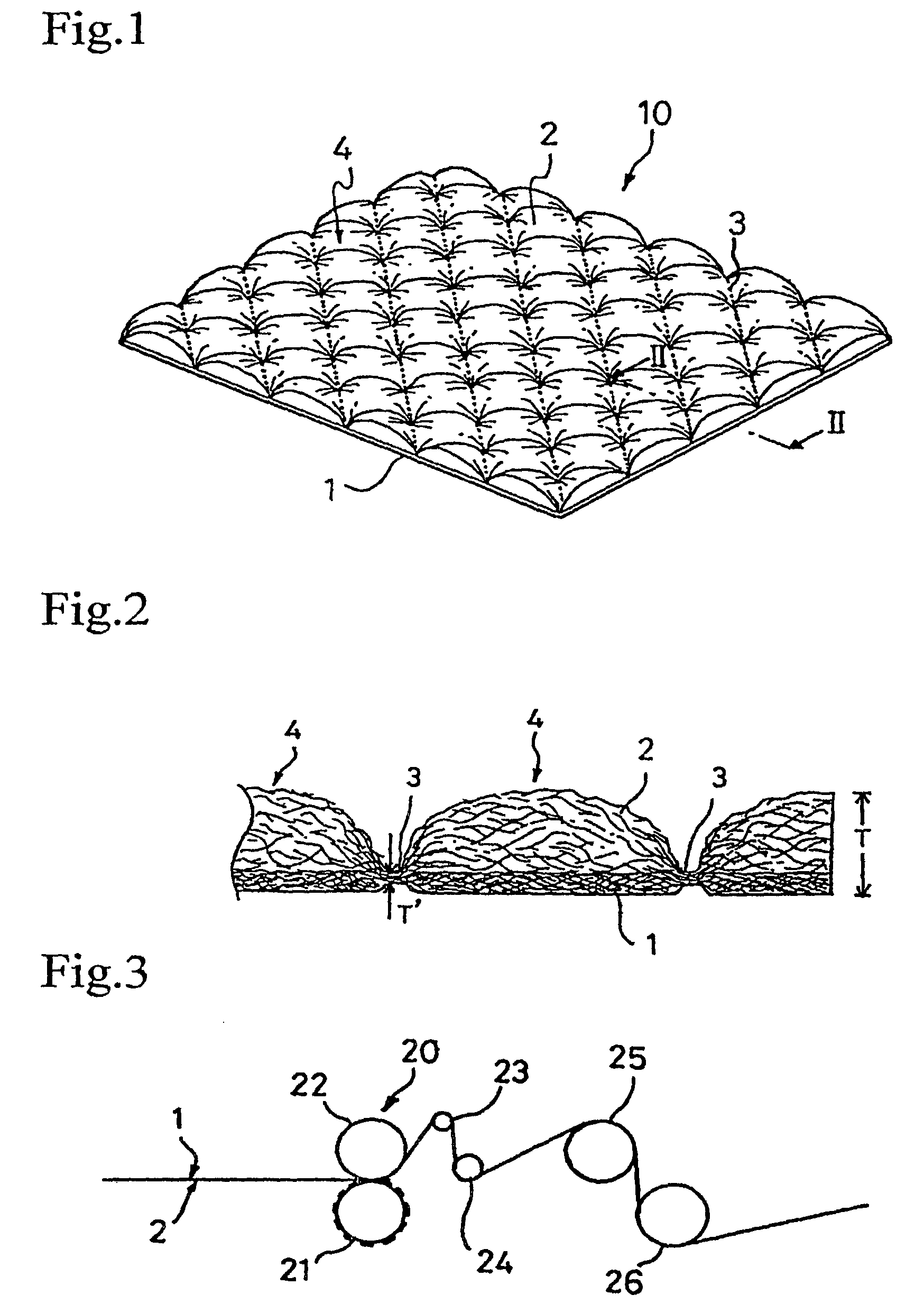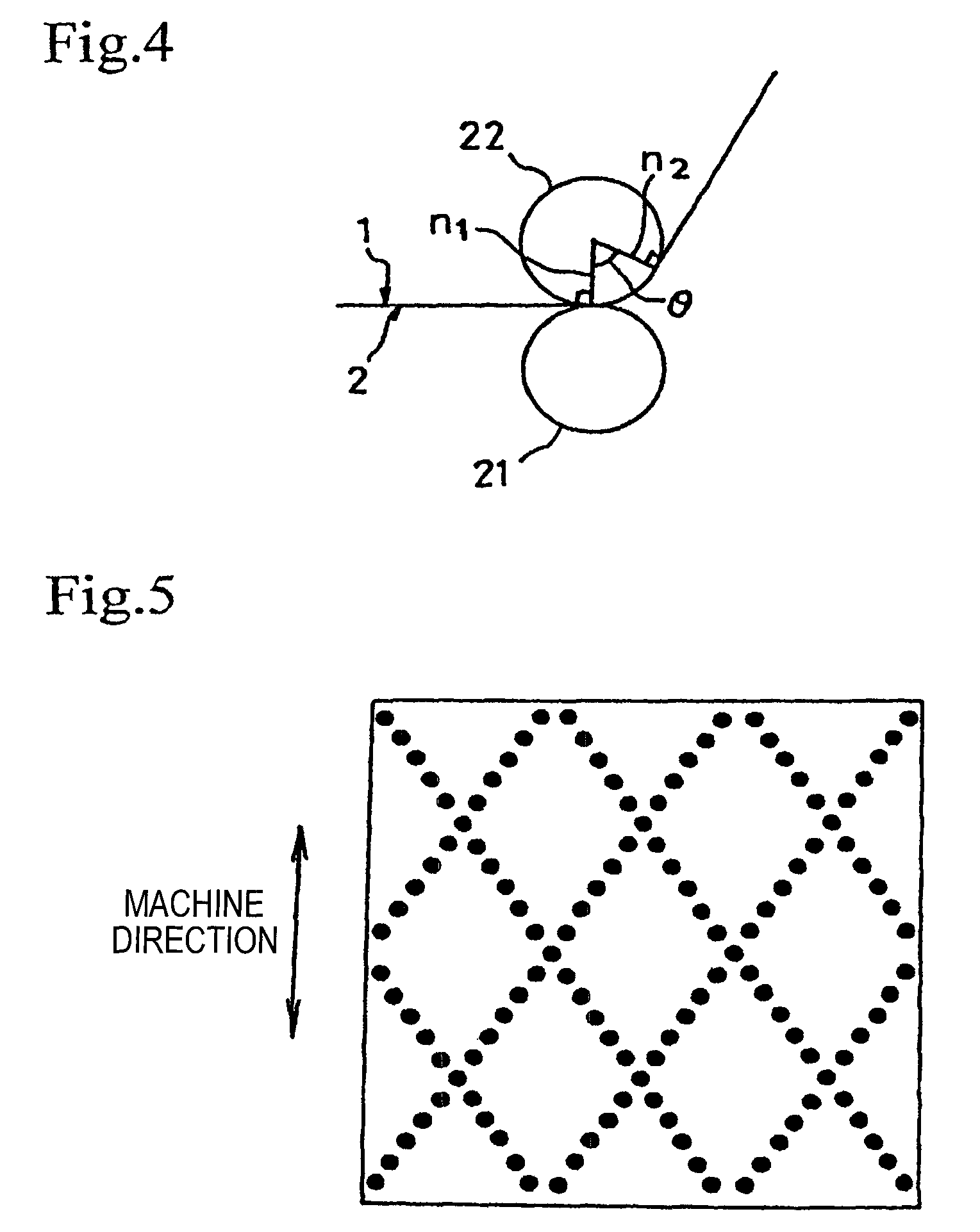Bulky sheet material having three-dimensional protrusions
a three-dimensional, bulky sheet technology, applied in the field of bulky sheet material, can solve the problems of limited bonding strength between the two layers, difficult to achieve the effect of retaining shape, good texture, and satisfactory appearan
- Summary
- Abstract
- Description
- Claims
- Application Information
AI Technical Summary
Benefits of technology
Problems solved by technology
Method used
Image
Examples
example 1
1) Preparation of First Fiber Layer-forming Material
[0064]Self-crimping fiber which was heat shrinkable core-sheath conjugate fiber consisting of polypropylene (PP) as a core and an ethylene-propylene copolymer (EP) as a sheath at a core / sheath weight ratio of 5 / 5 and having a fineness of 2.2 dtex, a fiber length of 51 mm, and a shrinkage starting temperature TS of 90° C. (CPP, available from Daiwabo Co., Ltd.) was carded with a roller carding machine to form a web having a basis weight of 12 g / m2.
2) Preparation of Second Fiber Layer-forming Material
[0065]Heat bondable core-sheath conjugate fiber consisting of polyethylene terephthalate (PET) as a core and polyethylene (PE) as a sheath at a core / sheath weight ratio of 5 / 5 and having a fineness of 2.2 dtex and a fiber length of 51 mm (NBF-SH, available from Daiwabo Co., Ltd.) was carded with a roller carding machine to form a web having a basis weight of 13 g / m2.
3) Preparation of Bulky Sheet Material
[0066]The two webs prepared in (1)...
example 2
[0068]A bulky sheet material was prepared in the same manner as in Example 1, except that the set temperatures of the engraved roll and the smooth roll were changed as shown in Table 1 below. The resulting bulky sheet material had a great number of protrusions formed of the second fiber layer being raised between the joints by the shrinkage of the first fiber layer, with the joints forming depressions.
example 3
[0069]A bulky sheet material was prepared in the same manner as in Example 1, except that (i) the set temperatures of the engraved roll and the smooth roll were changed as shown in Table 1 and (ii) the engraved roll had no heat insulating material in the depressions but, instead, (iii) the two webs were wrapped around the smooth roll at a wrap angle of 60° to apply tension in the CD. The resulting bulky sheet material had a great number of protrusions formed of the second fiber layer being raised between the joints by the shrinkage of the first fiber layer, with the joints forming depressions.
PUM
| Property | Measurement | Unit |
|---|---|---|
| wrap angle | aaaaa | aaaaa |
| melting point | aaaaa | aaaaa |
| shrinkage | aaaaa | aaaaa |
Abstract
Description
Claims
Application Information
 Login to View More
Login to View More - R&D
- Intellectual Property
- Life Sciences
- Materials
- Tech Scout
- Unparalleled Data Quality
- Higher Quality Content
- 60% Fewer Hallucinations
Browse by: Latest US Patents, China's latest patents, Technical Efficacy Thesaurus, Application Domain, Technology Topic, Popular Technical Reports.
© 2025 PatSnap. All rights reserved.Legal|Privacy policy|Modern Slavery Act Transparency Statement|Sitemap|About US| Contact US: help@patsnap.com



